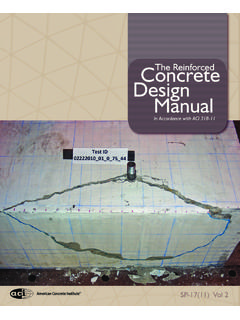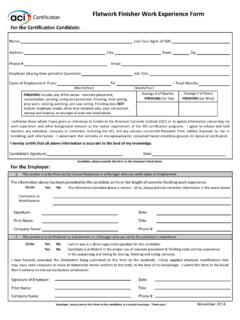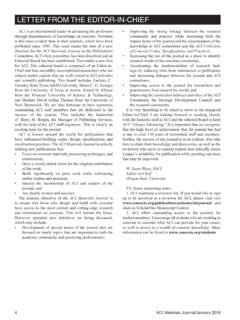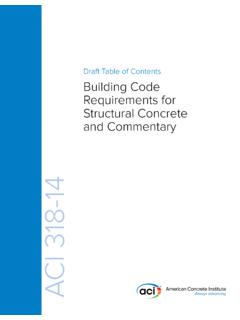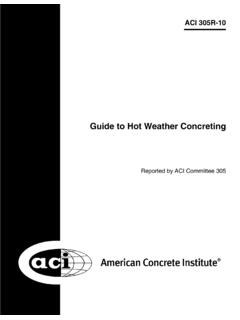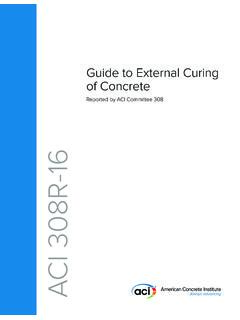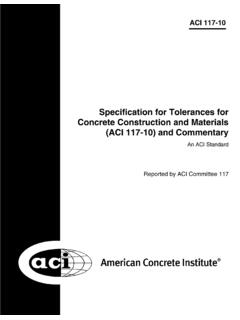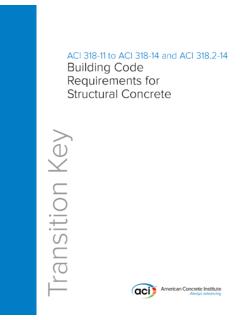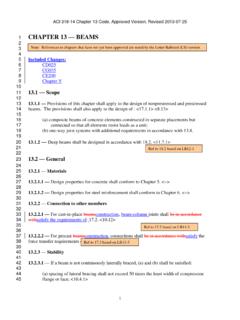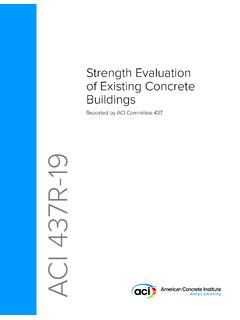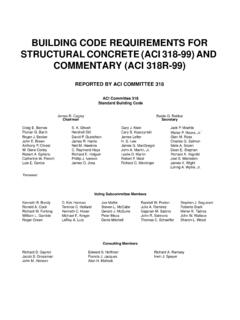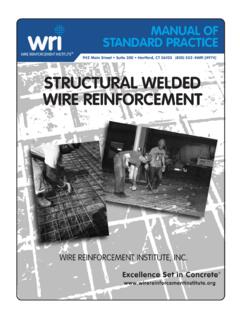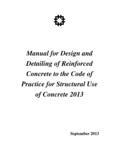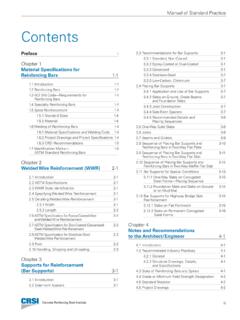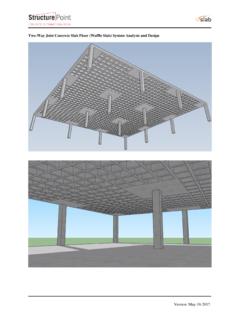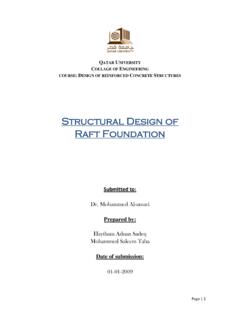Transcription of ACI 360R-10 Guide to Design of Slabs-on-Ground
1 ACI 360R-10 Reported by ACI Committee 360 Guide to Design of Slabs-on-GroundGuide to Design of Slabs-on-GroundFirst PrintingApril 2010 ISBN 978-0-87031-371-4 American Concrete Institute Advancing concrete knowledgeCopyright by the American Concrete Institute, Farmington Hills, MI. All rights reserved. This materialmay not be reproduced or copied, in whole or part, in any printed, mechanical, electronic, film, or otherdistribution and storage media, without the written consent of technical committees responsible for ACI committee reports and standards strive to avoid ambiguities,omissions, and errors in these documents. In spite of these efforts, the users of ACI documents occasionallyfind information or requirements that may be subject to more than one interpretation or may beincomplete or incorrect.
2 Users who have suggestions for the improvement of ACI documents arerequested to contact ACI. Proper use of this document includes periodically checking for errata for the most up-to-date committee documents are intended for the use of individuals who are competent to evaluate thesignificance and limitations of its content and recommendations and who will accept responsibility for theapplication of the material it contains. Individuals who use this publication in any way assume all risk andaccept total responsibility for the application and use of this information in this publication is provided as is without warranty of any kind, either express or implied,including but not limited to, the implied warranties of merchantability, fitness for a particular purpose and its members disclaim liability for damages of any kind, including any special, indirect, incidental,or consequential damages, including without limitation, lost revenues or lost profits.
3 Which may resultfrom the use of this is the responsibility of the user of this document to establish health and safety practices appropriate tothe specific circumstances involved with its use. ACI does not make any representations with regard tohealth and safety issues and the use of this document. The user must determine the applicability of allregulatory limitations before applying the document and must comply with all applicable laws and regulations,including but not limited to, United States Occupational Safety and Health Administration (OSHA) healthand safety information: ACI documents are available in print, by download, on CD-ROM, through electronicsubscription, or reprint and may be obtained by contacting ACI standards and committee reports are gathered together in the annually revised ACI Manual ofConcrete Practice (MCP).
4 American Concrete Institute38800 Country Club DriveFarmington Hills, MI :248-848-3700 360R-10 supersedes ACI 360R-06 and was adopted and published April 2010, American Concrete rights reserved including rights of reproduction and use in any form or by anymeans, including the making of copies by any photo process, or by electronic ormechanical device, printed, written, or oral, or recording for sound or visual reproduc-tion or for use in any knowledge or retrieval system or device, unless permission inwriting is obtained from the copyright proprietors. 360R-1 ACI Committee Reports, Guides, Manuals, and Commentariesare intended for guidance in planning, designing, executing,and inspecting construction. This document is intended for theuse of individuals who are competent to evaluate thesignificance and limitations of its content and recommendationsand who will accept responsibility for the application of thematerial it contains.
5 The American Concrete Institute disclaimsany and all responsibility for the stated principles. The Instituteshall not be liable for any loss or damage arising to this document shall not be made in contractdocuments. If items found in this document are desired by theArchitect/Engineer to be a part of the contract documents, theyshall be restated in mandatory language for incorporation bythe to Design of Slabs-on-GroundReported by ACI Committee 360 ACI 360R-10 This Guide presents information on the Design of Slabs-on-Ground ,primarily industrial floors. It addresses the planning, Design , and detailingof slabs. Background information on Design theories is followed by discussionof the types of slabs, soil-support systems, loadings, and jointing.
6 Designmethods are given for unreinforced concrete, reinforced concrete,shrinkage-compensating concrete, post-tensioned concrete, fiber-reinforcedconcrete Slabs-on-Ground , and Slabs-on-Ground in refrigerated buildings,followed by information on shrinkage and curling. Advantages anddisadvantages of these slab Design methods are provided, including theability of some slab designs to minimize cracking and curling more thanothers. Even with the best slab designs and proper construction, it isunrealistic to expect crack-free and curl-free floors. Every owner shouldbe advised by the designer and contractor that it is normal to expect somecracking and curling on every project.
7 This does not necessarily reflectadversely on the adequacy of the floor s Design or quality of examples are : curling; Design ; floors-on- ground ; grade floors; industrialfloors; joints; load types; post-tensioned concrete; reinforcement (steel,fibers); shrinkage; shrinkage-compensating; slabs; Slabs-on-Ground ; soilmechanics; 1 Introduction, p. Purpose and Work of ACI Committee 360 and other Work of non-ACI Design theories for Construction document Further researchChapter 2 Definitions, p. DefinitionsChapter 3 slab types, p. slab General comparison of slab Design and construction ConclusionChapter 4 Soil support systems forslabs-on- ground , p. Geotechnical engineering Subgrade Modulus of subgrade Design of slab -support Site preparationJ.
8 Howard AllredEdward B. FinkelDonald M. McPheeNigel K. ParkesCarl BimelBarry E. ForemanSteven N. MetzgerRoy H. ReitermanJoseph A. BohinskyTerry J. FricksJohn P. MundayJohn W. RohrerWilliam J. BrickeyPatrick J. HarrisonJoseph F. Neuber, M. TarrJoseph P. BuongiornoPaul B. LafontaineRussell E. NeudeckR. Gregory TaylorAllen FaceEd T. McGuireScott L. NiemitaloDonald G. W. YtterbergC. Rick FelderAndrew W. McKinneyWayne W. WalkerChairRobert B. AndersonVice ChairPhilip BrandtSecretary360R-2 ACI COMMITTEE Inspection and site testing of slab Special slab -on- ground support problemsChapter 5 Loads, p. Vehicular Concentrated Distributed Line and strip Unusual Construction Environmental Factors of safetyChapter 6 Joints, p.
9 Load-transfer Sawcut contraction Joint Joint filling and sealingChapter 7 Design of unreinforced concrete slabs, p. Thickness Design Shear transfer at Maximum joint spacingChapter 8 Design of slabs reinforced forcrack-width control, p. Thickness Design Reinforcement for crack-width control onlyChapter 9 Design of shrinkage-compensating concrete slabs, p. Thickness Other considerationsChapter 10 Design of post-tensionedslabs-on- ground , p. Applicable Design Slabs post-tensioned for crack Industrial slabs with post-tensioned reinforcementfor structural supportChapter 11 Fiber-reinforced concreteslabs-on- ground , p. Synthetic fiber Steel fiber reinforcementChapter 12 Structural Slabs-on-Ground supporting building code loads, p.
10 Design considerationsChapter 13 Design of slabs for refrigerated facilities, p. Design and specification Temperature drawdownChapter 14 Reducing effects of slab shrinkage and curling, p. Drying and thermal Curling and Factors that affect shrinkage and Compressive strength and Compressive strength and abrasion Removing restraints to Base and vapor Distributed reinforcement to reduce curling andnumber of Thickened edges to reduce Relation between curing and Warping stresses in relation to joint Warping stresses and Effect of eliminating sawcut contraction joints withpost-tensioning or shrinkage-compensating Summary and conclusionsChapter 15 References, p. Referenced standards and Cited referencesAppendix 1 Design examples using Portland Cement Association method, p.
